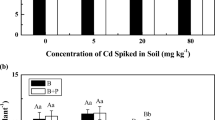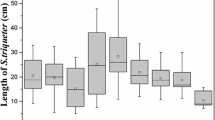Abstract
Purpose
The increasing land application of sewage sludge and animal manure has accelerated the input of 17α-ethynylestradiol (EE2) into soils and environment, which would influence the health of vegetables and also the hormonal system of animals. In order to remove EE2 from soils, one possible option is bioremediation by using EE2-degrading microorganism or/and EE2-accumulating plants. The study attempted to isolate EE2-degrading microorganism from soils, and investigate the effect of this microorganism and/or organic pollutant removable plant Lolium perenne on the removal of EE2 from soil.
Materials and methods
EE2-degrading bacteria Hyphomicrobium sp. GHH was obtained from farmland soil. Pot experiments were taken to investigate the inoculation of Hyphomicrobium sp. GHH, cultivation of L. perenne, and inoculation of Hyphomicrobium sp. GHH + cultivation of L. perenne on the EE2 removal from soil. The plant biomass, EE2 concentration in plant root and shoot, phytoremediation efficiency, and the soil urease activity and dehydrogenase activity were determined to evaluate the interaction of plant and microbe on EE2 removal from soil.
Results and discussion
The inoculation of Hyphomicrobium sp. GHH significantly increased root length of L. perenne as well as EE2 concentrations in root and shoot (P < 0.05). On days 14, 28, and 42 after the treatment with l. perenne cultivation alone, the phytoextraction efficiency of EE2 was 16.5, 25.2, and 29.8%, respectively, while this phytoextraction efficiency was improved by 82.0, 44.0, and 41.0%, respectively, with the inoculation of Hyphomicrobium sp. GHH. On days 28 and 42, the combination of Hyphomicrobium sp. GHH with l. perenne removed 94.0 and 99.0% of EE2, respectively, from the soil. EE2 was mainly stored in the root of L. perenne, with all the translocation factor (TF) values < 1. The promoting effect of different treatments on the removal efficiency of EE2 decreased in the order: L. perenne + Hyphomicrobium sp. GHH > L. perenne alone > Hyphomicrobium sp. GHH. This was consistent with the changing trend of the activities of soil urease and dehydrogenase, indicating that plant cultivation stimulated the growth of rhizospheric microorganisms.
Conclusions
Application of Hyphomicrobium sp. GHH in combination with L. perenne has great potential for remediating EE2-contaminated soil, and plant-microbe interaction has synergistic effect on the EE2 removal.






Similar content being viewed by others
References
Bao SD (2000) Soil agro-chemistrical analysis. China Agriculture Press, Beijing
Bianco C, Defez R (2009) Medicago truncatula improves salt tolerance when nodulated by an indole-3-acetic acid-overproducing Sinorhizobium meliloti strain. J Exp Bot 60:3097–3107
Binet P, Portal JM, Leyval C (2000) Dissipation of 3-6-ring polycyclic aromatic hydrocarbons in the rhizosphere of ryegrass. Soil Biol Biochem 32:2011–2017
Briggs GG, Bromilow RH, Evans AA (1982) Relationships between lipophilicity and root uptake and translocation of non-ionised chemicals by barley. J Pestic Sci 14:492–500
Carr DL, Morse AN, Zak JC, Anderson TA (2010) Microbially mediated degradation of common pharmaceuticals and personal care products in soil under aerobic and reduced oxygen conditions. Water Air Soil Pollut 216:633–642
Chang HS, Choo KH, Lee B, Choi SJ (2009) The methods of identification, analysis, and removal of endocrine disrupting compounds (EDCs) in water. J Hazard Mater 172:1–12
Chiou CT, Sheng GY, Manes M (2001) A partition-limited model for the plant uptake of organic contaminants from soil and water. Environ Sci Technol 35:1437–1444
Delclos KB, Weis CC, Bucci TJ, Olson G, Mellick P, Sadovova N, Latendresse JR, Thorn B, Newbold RR (2009) Overlapping but distinct effects of genistein and ethinyl estradiol (EE2) in female Sprague-Dawley rats in multigenerational reproductive and chronic toxicity studies. Reprod Toxicol 27:117–132
Flores MIA, Romero-González R, Frenich AG, Vidal JLM (2011) QuEChERS-based extraction procedure for multifamily analysis of phytohormones in vegetables by UHPLC-MS/MS. J Sep Sci 34:1517–1524
Ganesan V (2008) Rhizoremediation of cadmium soil using a cadmium-resistant plant growth-promoting rhizopseudomonad. Curr Microbiol 56:403–407
Gerhardt KE, Huang XD, Glick BR, Greenberg BM (2009) Phytoremediation and rhizoremediation of organic soil contaminants: potential and challenges. Plant Sci 176:20–30
Gianfreda L, Antonietta Rao M, Piotrowska A, Palumbo G, Colombo C (2005) Soil enzyme activities as affected by anthropogenic alterations: intensive agricultural practices and organic pollution. Sci Total Environ 341:265–279
Glick BR (2010) Using soil bacteria to facilitate phytoremediation. Biotechnol Adv 28:367–374
Glick BR, Todorovic B, Czarny J, Cheng Z, Duan J, McConkey B (2007) Promotion of plant growth by bacterial ACC deaminase. Crit Rev Plant Sci 26:227–242
Guo H, Yao J, Cai MM, Qian YG, Guo Y, Richnow HH, Blake RE, Doni S, Ceccanti B (2012) Effects of petroleum contamination on soil microbial numbers, metabolic activity and urease activity. Chemosphere 87:1273–1280
He SY, Wu QL, He ZL (2014a) Growth-promoting hormone DA-6 assists phytoextraction and detoxification of cd by ryegrass. Int J Phytoremediat 17:597–603
He SY, Wu QL, He ZL (2014b) Synergetic effects of DA-6/GA(3) with EDTA on plant growth, extraction and detoxification of cd by Lolium perenne. Chemosphere 117:132–138
Hildebrand C, Londry K, Farenhorst A (2006) Sorption and desorption of three endocrine disrupters in soils. J Environ Sci Health B 41:907–921
Hogan NS, Duarte P, Wade MG, Lean DR, Trudeau VL (2008) Estrogenic exposure affects metamorphosis and alters sex ratios in the northern leopard frog (Rana pipiens): identifying critically vulnerable periods of development. Gen Comp Endocrinol 156:515–523
Huang HG, Yu N, Wang LJ, Gupta DK, He ZL, Wang K, Zhu ZQ, Yan XC, Li TQ, Yang XE (2011) The phytoremediation potential of bioenergy crop Ricinus communis for DDTs and cadmium co-contaminated soil. Bioresour Technol 102:11034–11038
Karnjanapiboonwong A, Chase DA, Canas JE, Jackson WA, Maul JD, Morse AN, Anderson TA (2011) Uptake of 17α-ethynylestradiol and triclosan in pinto bean, Phaseolus vulgaris. Ecotoxicol Environ Saf 74:1336–1342
Kuster M, López de Alda MJ, Barceló D (2005) Estrogens and progestogens in wastewater, sludge, sediments, and soil. Water Pollut 2:1–24
Larcher S, Yargeau V (2013) Biodegradation of 17α-ethinylestradiol by heterotrophic bacteria. Environ Pollut 173:17–22
Larcher S, Delbes G, Robaire B, Yargeau V (2012) Degradation of 17α-ethinylestradiol by ozonation--identification of the by-products and assessment of their estrogenicity and toxicity. Environ Int 39:66–72
Lima DL, Calisto V, Esteves VI (2011) Adsorption behavior of 17α-ethynylestradiol onto soils followed by fluorescence spectral deconvolution. Chemosphere 84:1072–1078
Liu B, Wu F, Deng NS (2002) UV-light induced photodegradation of 17alpha-ethynylestradiol in aqueous solutions. J Hazard Mater 98(1):311–316
Liu R, Dai YY, Sun LB (2015) Effect of rhizosphere enzymes on phytoremediation in PAH-contaminated soil using five plant species. PLoS One 10:e0120369
Ma Y, Rajkumar M, Freitas H (2009) Inoculation of plant growth promoting bacterium Achromobacter xylosoxidans strain Ax10 for the improvement of copper phytoextraction by Brassica juncea. J Environ Manag 90:831–837
Macek T, Mackova M, Kas J (2000) Exploitation of plants for the removal of organics in environmental remediation. Biotechnol Adv 18:23–34
Mazellier P, Meite L, De Laat J (2008) Photodegradation of the steroid hormones 17β-estradiol (E2) and 17α-ethinylestradiol (EE2) in dilute aqueous solution. Chemosphere 73:1216–1223
Mehmannavaz R, Prasher SO, Ahmad D (2002) Rhizospheric effects of alfalfa on biotransformation ofpolychlorinated biphenyls in a contaminated soil augmented withSinorhizobiummeliloti. Process Biochem 37:955–963
Morikawa H, Erkin ÖC (2003) Basic processes in phytoremediation and some applications to air pollution control. Chemosphere 52:1553–1558
Pauwels B, Wille K, Noppe H, De Brabander H, Van de Wiele T, Verstraete W, Boon N (2008) 17α-ethinylestradiol cometabolism by bacteria degrading estrone, 17β-estradiol and estriol. Biodegradation 19:683–693
Ren HY, Ji SL, Naeem ud din A, Wang D, Cui CW (2007) Degradation characteristics and metabolic pathway of 17α-ethynylestradiol by Sphingobacterium sp. JCR5. Chemosphere 66:340–346
Sabirova JS, Cloetens LF, Vanhaecke L, Forrez I, Verstraete W, Boon N (2008) Manganese-oxidizing bacteria mediate the degradation of 17α-ethinylestradiol. Microb Biotechnol 1:507–512
Schnoor JL, Licht LA, McCutcheon SC, Wolfe NL, Carreira LH (1995) Phytoremediation of organic and nutrient contaminants. Environ Sci Technol 29:318–323
Schroeder LM, Blackwell B, Klein D, Morse AN (2015) Rate uptake of three common pharmaceuticals in celery, Apium Graveolens. Water AirSoil Pollut 226:123
Sheng XF, Xia JJ, Jiang CY, He LY, Qian M (2008) Characterization of heavy metal-resistant endophytic bacteria from rape (Brassica napus) roots and their potential in promoting the growth and lead accumulation of rape. Environ Pollut 156:1164–1170
Stumpe B, Marschner B (2009) Factors controlling the biodegradation of 17β-estradiol, estrone and 17α-ethinylestradiol in different natural soils. Chemosphere 74:556–562
Su YH, Zhu YG (2007) Transport mechanisms for the uptake of organic compounds by rice (Oryza sativa) roots. Environ Pollut 148:94–100
Tang JC, Wang RG, Niu XW, Zhou QX (2010) Enhancement of soil petroleum remediation by using a combination of ryegrass (Lolium perenne) and different microorganisms. Soil Tillage Res 110:87–93
Teng Y, Shen YY, Luo YM, Sun XH, Sun MM, Fu DQ, Li ZG, Christie P (2011) Influence of Rhizobium meliloti on phytoremediation of polycyclic aromatic hydrocarbons by alfalfa in an aged contaminated soil. J Hazard Mater 186:1271–1276
Tomšíková H, Aufartová J, Solich P, Nováková L, Sosa-Ferrera Z, Santana-Rodríguez JJ (2012) High-sensitivity analysis of female-steroid hormones in environmental samples. Ttac-Trend Anal Chem 34:35–58
Tran TN, Kim DG, Ko SO (2018) Synergistic effects of biogenic manganese oxide and Mn (II)-oxidizing bacterium Pseudomonas putida strain MnB1 on the degradation of 17 α-ethinylestradiol. J Hazard Mater 344:350–359
Wang YY, Fang L, Lin L, Luan TG, Tam NFY (2014) Effects of low molecular-weight organic acids and dehydrogenase activity in rhizosphere sediments of mangrove plants on phytoremediation of polycyclic aromatic hydrocarbons. Chemosphere 99:152–159
White JC, Parrish ZD, Isleyen M, Gent MPN, Iannucci-Berger W, Eitzer BD, Mattina MJI (2005) Uptake of weathered p,p′-DDE by plant species effective at accumulating soil elements. Microchem J 81:148–155
Xu H, Yang J, Wang YX, Jiang Q, Chen H, Song HY (2008) Exposure to 17α-ethynylestradiol impairs reproductive functions of both male and female zebrafish (Danio rerio). Aquat Toxicol 88:1–8
Xu N, Johnson AC, Jürgens MD, Llewellyn NR, Hankins NP, Darton RC (2009) Estrogen concentration affects its biodegradation rate in activated sludge. Environ Toxicol Chem 28:2263–2270
Xu Y, Sun GD, Jin JH, Liu Y, Luo M, Zhong ZP, Liu ZP (2014) Successful bioremediation of an aged and heavily contaminated soil using a microbial/plant combination strategy. J Hazard Mater 264:430–438
Zhang X, Gao YJ, Li QZ, Li GX, Guo QH, Yan CZ (2011) Estrogenic compounds and estrogenicity in surface water, sediments, and organisms from Yundang lagoon in Xiamen, China. Arch Environ Contam Toxicol 61:93–100
Zhou X, Lian ZR, Wang JT, Tan LJ, Zhao ZC (2011) Distribution of estrogens along Licun River in Qingdao, China. Procedia Environ Sci 10:1876–1880
Zhu ZQ, Yang XE, Wang K, Huang HG, Zhang X, Fang H, Li TQ, Alva AK, He ZL (2012) Bioremediation of cd-DDT co-contaminated soil using the cd-hyperaccumulator Sedum alfredii and DDT-degrading microbes. J Hazard Mater 235-236:144–151
Funding
This study was supported by the grant from National Natural Science Foundation of China (41501521, 41301327).
Author information
Authors and Affiliations
Corresponding author
Additional information
Responsible editor: Daniel C. W. Tsang
Rights and permissions
About this article
Cite this article
He, S., Guo, H., He, Z. et al. Interaction of Lolium perenne and Hyphomicrobium sp. GHH enhances the removal of 17α-ethinyestradiol (EE2) from soil. J Soils Sediments 19, 1297–1305 (2019). https://doi.org/10.1007/s11368-018-2116-y
Received:
Accepted:
Published:
Issue Date:
DOI: https://doi.org/10.1007/s11368-018-2116-y




